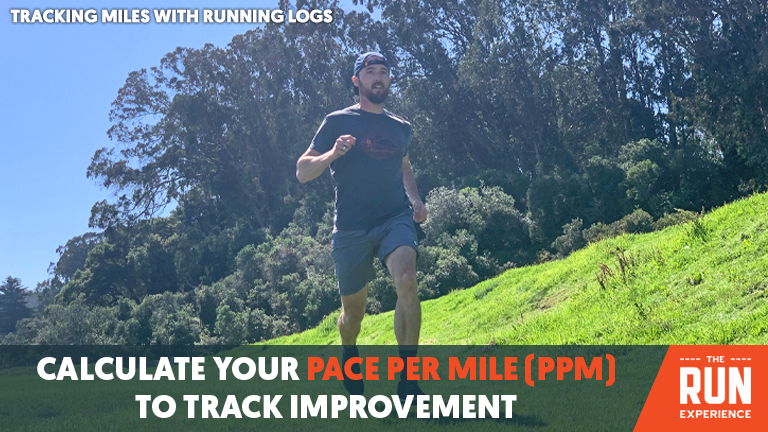Running Training Logs: How to Log Your Runs
Running logs are an essential part of any training plan. Discover how to log your runs and unlock the performance data you need to track.

Want to log your runs to actually improve your training (and not just your Strava follower count)? Simple running training logs might remind you of your high school cross-country glory days when you’d whip out your binder and write down your mile splits after a long, hot run in the summer sun.
Good times.
This habit of recording daily mileage is a special moment for some runners. However, just keeping a simple running log might not give you the data you need to optimize your performance. How you log your runs is just as important.
For others, this process doesn’t exist. Some just run without taking a minute to take stock of their achievements, assess pain points, and map out a plan for improvement. Running logs are an essential part of any training plan. Those who aren’t actively logging their miles throughout training are doing a disservice to themselves.
What Are Running Training Logs?
First, what is a running log? A running log book is a daily record of your running progress. Consider it your athletic journal.
Your running log includes details about each run, including:
- Mileage
- Time
- Elevation
- Pace
- Splits
- Perceived effort
- Heart rate
- Heart rate zones
- Cadence
- Shoes
- Route
- Surface
Obviously, you don’t need to track all of these data points—but more data, more better. Right?
Not necessarily. Sometimes, extra (non-essential) data points can trip us up. Only track and focus on what you care about.
For example, if you don’t care about your pace and just want to build your aerobic base and endurance, tracking your pace with every running log might distract you. You might inadvertently try to beat your previous pace and lose track of your training goals.
Don’t worry about that just yet—we’ll show you how to log your runs further down the page. We just wanted to give you a taste of what a simple running log might include.
Running Logs vs. Training Logs: What's the Difference?
At a glance, "running logs" and "training logs" might seem like interchangeable terms, especially within the context of long-distance running or marathon prep. However, there are subtle but essential distinctions between the two.
Running Logs
- Nature and Focus: Running logs primarily track details related to your runs. They're often simpler in design and focus on the core aspects of each run.
- Data Points: Typical entries might include the date, distance covered, duration or pace of the run, type of run (e.g., tempo, interval, long run), and possibly the route taken.
- Purpose: They help runners see their progress over time, understand their running habits, and note patterns or trends in their running, like mileage increments or fluctuations in pace.
- Usage: Runners of all levels, from beginners to elite, might maintain a running log. It's particularly beneficial for those who primarily want to track their running consistency and progress.
Training Logs
- Nature and Focus: Training logs encompass a broader spectrum of athletic activity and training-related information. They offer a more holistic overview of an athlete's preparation and well-being.
- Data Points: Beyond the running specifics, training logs might include details on cross-training activities, strength training sessions, rest days, daily nutrition, sleep patterns, perceived effort, post-run recovery techniques, injuries, moods, and even weather conditions.
- Purpose: By providing a comprehensive view of an athlete's training regimen, these logs aid in understanding the interplay between different activities and the overall impact on performance. They can help pinpoint what's working and what's not, allowing for more informed adjustments to a training plan.
- Usage: While they're beneficial for runners of all levels, training logs are particularly valuable for serious or elite athletes, or those training for a specific goal or event, like a marathon or triathlon. They are also useful for individuals juggling multiple sports or training modalities.
While running logs zoom in on the specifics of each run, training logs pull back to offer a panoramic view of an athlete's overall training landscape. Depending on one's goals, maintaining both can be advantageous. A running log can offer a clear and quick snapshot of one's running journey, while a training log provides a detailed diary of the holistic training experience, helping to inform decisions and fine-tune strategies for optimal performance.
Why You Need a Running Training Log
Running logs provide value in many different ways. Depending on your training and style, you might use a running log in a way that’s different from another runner. However, most would agree that the three most compelling reasons to record mileage in a running log include: tracking your progress, making adjustments to training, and holding yourself accountable.
1. Track your progress
If you didn’t write down yesterday’s mileage, how do you know what you have to beat today? Saving your mile splits in your watch can be cumbersome to retrieve. Running logs lay all your stats out for you in a weekly, monthly, and yearly view. They can show your improvements over time. As you log workouts, your achievements will become more tangible.
2. Make adjustments to training
Running logs provide a historical catalogue of your past runs. If you fill them out correctly, you should be able to know what workout you did, how long it took, and how you were feeling on a Tuesday six months ago. This enables you to do a comparative analysis to see how weather, terrain, and different types of runs impact your speed, recovery, and overall health.
No training plan is ever set in stone. With a running log, you can easily make adjustments to your training when necessary and still hit your allotted mileage for the week. This will keep you on track and moving forward despite any setbacks in your way.
3. Hold yourself accountable
Lastly, running logs help keep yourself accountable. There’s something magical about looking down at your log after a productive week or month of running and seeing every box filled. By keeping a running log, you’ll want to record your day’s work. After seeing how each run builds upon the previous one, you’ll be more incentivized to get after your next workout. Your log will be waiting for you when you get back. You know what you have to do.
Types of Running Logs
The way runners log their workouts and record their mileage has—like most things—evolved over the years. The only wrong way to log your miles is by simply neglecting the process altogether. Test out different running logs to see which works best for you. Some of the most common ones used are paper logs, digital logs, and mobile apps.
Simple running logs are sometimes better than complicated running training logs, so don’t get caught up in bigger is better. Often, a good ol’ fashioned pen and paper does the trick better than a tech-cramped running app.
1. Old-Fashioned Pen and Paper
If you haven’t been religiously keeping one all these years, the phrase “running log” might evoke images of an old binder with papers chaotically exploding from it. Keeping track of your miles in a notebook or on a printed out log is an effective, simple way to get the job done. You can put loose papers in a binder, and start a new sheet at the beginning of each month.

2. Digital Running Logs
If you want to elevate your running log and bring it into the 21st century, consider a digital running log. This can be as simple as a Microsoft Excel spreadsheet, Google doc, or even an online software that allows you to input your mileage, splits, and times. For example, you could use a Garmin Connect and sync the data to your account. After it’s transferred over digitally, you can evaluate and make tweaks to your training program if needed.
3. Mobile Apps
Mobile apps are a quick and easy way to log your miles in just a few taps on your iPhone or Android. Since you likely have your smartphone with you, this makes your running log accessible at any point in time. In addition, there’s plenty of apps that sync to your wearables and even ones that will track your workouts for you as you run. Don’t stop there, though. Download The Run Experience app as a perfect complement to your running log. You’ll find training advice, videos, community, and tips from our dedicated coaches.
5 Key Metrics to Log Your Runs
So now that you’re ready to start using a running log, what exactly should you keep track of? Think of your running log as a journal or tracker that captures as much data as possible from your run. This could include your total mileage, run time, mile splits, run type, and run notes.
1. Total Mileage
Recording your total mileage is one of the main aspects of keeping a running log. This helps ensure you reach your weekly mileage and stay on track for your training plan. It also is useful to compare your total mileage on a daily, weekly, or monthly basis to the same period a year prior. This will show how much you’ve progressed or regressed since that time.
2. Total Run Time
You’ll likely remember your PR’s off of the top of your head, but what about everything else? Running logs help bring to light the seconds you’ve shaved off your time for specific training runs. Tracking your total run time helps you understand if you’re getting faster or slower, while providing deeper analysis for other variables that may be impacting your performance.
3. Mile Splits
You can only manage your average pace per mile during a race if you understand your individual mile page. If you’re using a paper running log, record your mile splits on the back of your monthly sheet. This can be a helpful reference tool if you’re doing interval training or another high-intensity workout that requires specific mile or quarter-mile splits.

4. Run Type
Depending on your training program, you could have a variety of different run types that impact your mileage and run time. That’s why it’s important to record what type of training run you’re doing for each entry. Are you running at race pace or doing a recovery run? Is it a timed mile, warm up, or interval training? All of these will impact how you view that specific record months from now.

5. Run Notes
There are so many different variables that can impact your run. What was the weather like? Was the trail flooded? Were you up all night tossing and turning? Have you been wrestling with tendonitis for the last few days? Whatever it is, write it down. Your running log will be more comprehensive and helpful if you include additional details.
Maintaining Your Running Training Log
In order for your running log to be useful, you must commit to filling it out every day. Running logs with spotty, dirty data won’t help you track performance. Instead, they’ll leave you confused, lost, and even a bit discouraged.
Here are a few tips to making it easier to fill out your running log:
- Take your log with you to every run. Leave it in your car. It’ll be there waiting.
- Fill out your running log every day. Use rest days to evaluate your performance.
- Make it a ritual to fill it out. It should become a part of your daily running routine.
- Always be 100% truthful. Record your good and bad runs.
- Take some time at the end of the month to review your performance data.
Once you form the habit of filling out your running log, it should feel weird if you’re ever finishing a run without doing it.
Our Favorite Running Log Book
While you can find plenty of running log books on the market, we've found one tried-and-true solution that stands above the rest. It's the Racin' Grayson Training Log and Planner.
FAQs about Running Training Logs
To help you get the most out of your running training logs, we've compiled a list of frequently asked questions. This section will address common concerns and provide additional insights to ensure you're logging your runs effectively and efficiently.
1. What is a running training log?
A running training log is a detailed record of your running activities, capturing essential data points such as mileage, time, pace, splits, perceived effort, and more. It serves as an athletic journal that helps you track your progress, make training adjustments, and stay accountable.
2. Why should I use a running log?
Using a running log provides several benefits:
- Track Progress: Monitor improvements in your performance over time.
- Adjust Training: Make informed adjustments to your training plan based on historical data.
- Accountability: Stay motivated and committed by recording each run and seeing your progress.
3. How often should I fill out my running log?
For the most accurate and beneficial record, fill out your running log immediately after each run. This ensures that all details are fresh in your mind and your log remains up-to-date.
4. How can I use my running log to improve my performance?
- Analyze Trends: Review your logs regularly to identify trends and patterns in your training.
- Adjust Plans: Make adjustments to your training plan based on your logged data, such as modifying mileage or incorporating more rest days.
- Set Goals: Use your log to set realistic and achievable goals, then track your progress toward these goals.
5. What if I miss a day or forget to log a run?
While it's best to log every run, missing an entry occasionally isn't the end of the world. Try to log the missed run as soon as possible with as much detail as you can remember. Consistency is key, so make it a habit to log runs immediately after finishing them.
6. How detailed should my running log be?
The level of detail depends on your personal goals and what information you find most useful. At a minimum, track your mileage, time, and type of run. More detailed logs can include additional data like splits, heart rate, and personal notes.
Tracking for Success
Running logs enable runners to track their progress, make adjustments to training, and hold themselves accountable. It can be a useful tool in guiding runners to become the best version of themselves and maximize every run.
No matter how you do it, take some time at the end of every run to record your miles in order to evaluate your performance over time. By doing so, you’ll be continuously challenging yourself to get better, while focusing on your improvements every step of the way.
